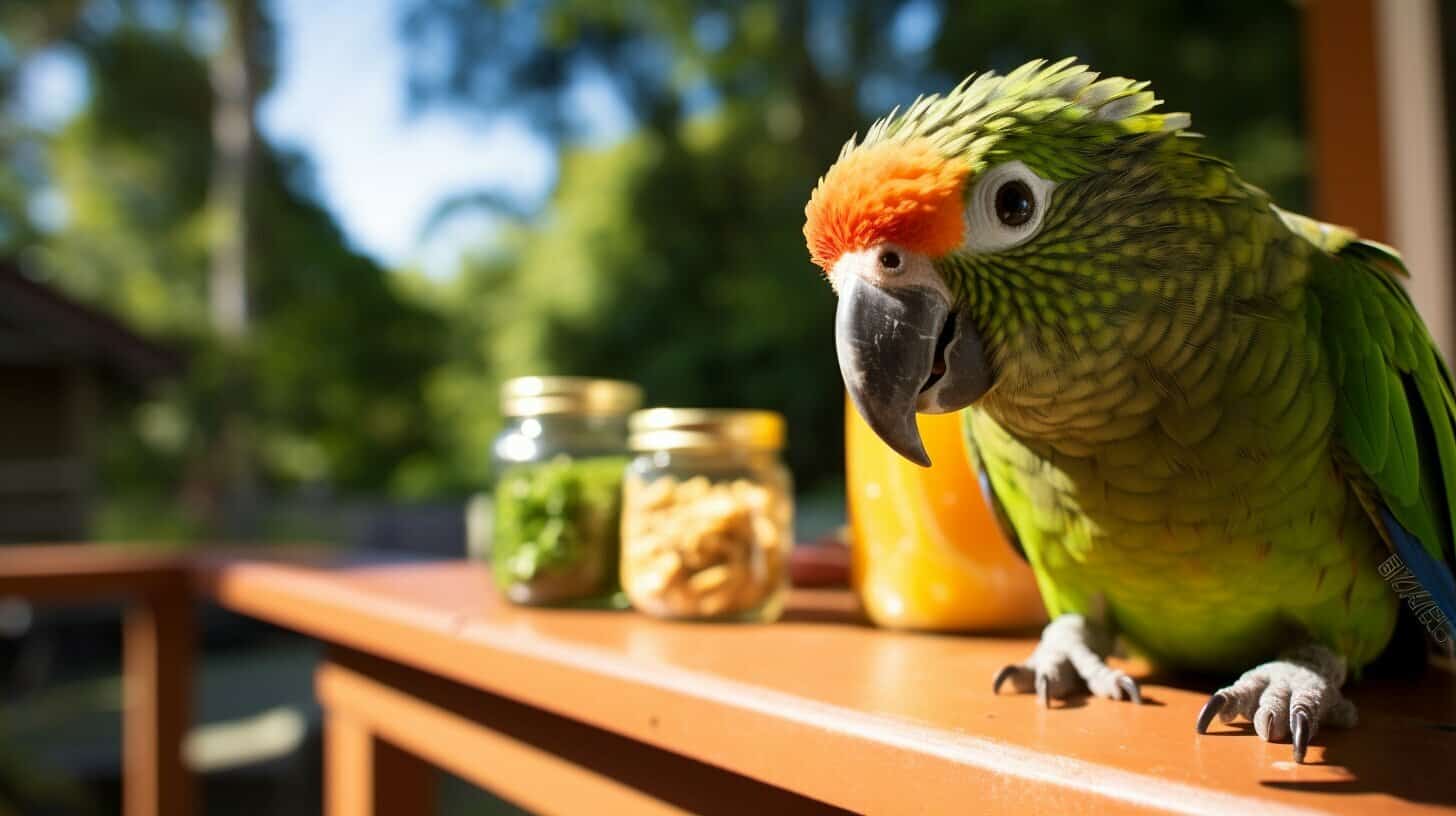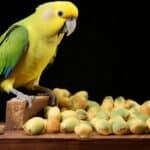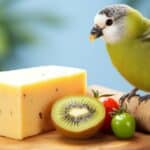If you’re a proud owner of a kakariki, you’re probably always looking for tasty treats to provide your feathered friend. One common question that many pet bird owners ask is whether kakarikis can safely eat peanut butter.
In this section, we’ll explore the possible risks of feeding peanut butter to your bird and provide you with alternative, safe treats to indulge your pet. But first, let’s take a closer look at the basic dietary needs of kakarikis to ensure they receive the best possible care.
Can Kakarikis eat peanut butter? Kakarikis can technically eat peanut butter. However, it may not be the best source of food for them. Peanut butter is high in fat which can lead to obesity in birds. Additionally, some makes of peanut butter contain ingredients that are harmful to kakarikis.
Key Takeaways:
- Kakarikis are beloved pet birds with specific dietary needs.
- Feeding peanut butter to your bird can harm their health and well-being.
- Alternative treats are available that are safe and enjoyable for your feathered friend.
Understanding the Kakariki Diet
Before we dive into whether kakarikis can eat peanut butter, it’s important to understand their dietary needs.
Kakarikis are omnivores and require a balanced diet that includes a variety of foods to stay healthy. Their diet should include seeds, fruits, vegetables, and protein sources such as cooked lean meat, boiled egg, or insects.
It’s important to avoid giving your kakariki foods high in salt, sugar, or fat, as these can lead to health problems such as obesity and heart disease.
Some safe foods for kakarikis include:
- Leafy greens such as spinach and kale
- Fruits such as apple, banana, and berries
- Veggies such as broccoli, carrots, and sweet potato
- Seeds such as sunflower and millet
- Protein sources such as cooked lean meat, boiled egg, and insects
Maintaining a nutritious diet is essential for the health and well-being of your kakariki. Consult with your avian veterinarian to ensure your bird’s dietary needs are fully met.
The Risks of Feeding Peanut Butter to Kakarikis
If you’re wondering whether or not to offer your kakariki some peanut butter, it’s worth considering the risks associated with this popular human food. While it may be tempting to share your favourite treat with your feathered friend, certain aspects of peanut butter can pose hazards to birds.
| Risk | Description |
|---|---|
| High fat content | Peanut butter is high in fat, which can lead to obesity and related health issues in kakarikis. |
| Xylitol | Sugar-free and “no added sugar” peanut butter often contains xylitol, a toxic bird sweetener. |
| Mould | Stale or improperly stored peanut butter can contain harmful mould that can cause respiratory issues in birds. |
Even if peanut butter seems a harmless and tasty treat for your kakariki, it’s important to remember that birds can be sensitive to certain foods and substances. So, before feeding your bird any new food, it’s always best to consult with an avian veterinarian or an experienced bird keepers’ community.
Why Peanut Butter May Not Be Suitable for Kakarikis
If you’re considering feeding your kakariki peanut butter, it’s important to understand why this may not be the best choice.
Firstly, peanut butter is high in fat, which is not ideal for birds. Birds have a faster metabolism than humans, and too much fat in their diet can lead to obesity and related health issues.
Additionally, some varieties of peanut butter contain added sugars and other harmful ingredients that can be toxic to birds. These ingredients can cause digestive problems and may even be fatal.
Another concern is that some birds may be allergic to peanuts, which can cause a range of symptoms from mild irritation to severe respiratory distress. Although rare, it’s important to be aware of this risk when considering peanut butter as a treat for your kakariki.
Finally, it’s worth noting that peanut butter is not a natural bird food. While occasional treats can be a fun way to bond with your pet, it’s best to stick to foods that are safe and beneficial for your kakariki’s overall health.
If you’re wondering what treats are safe and enjoyable for your kakariki, check out our section on alternative treats.
Alternative Treats for Kakarikis
If you’ve decided that peanut butter may not be the best option for your kakariki, don’t worry! Plenty of alternative treats can be just as healthy and enjoyable for your feathered friend.
A great place to start is with fresh fruits and veggies. Kakarikis love a variety of colourful produce, such as apples, grapes, spinach, carrots, and broccoli. Not only are these foods packed with vitamins and nutrients, but they also provide a fun and interactive experience for your bird.
Another option is to offer your kakariki some seed or nut mixes. However, it’s important to do your research and ensure that the seeds and nuts are safe for your bird to consume. Some popular choices for kakarikis include sunflower seeds, pumpkin seeds, and almonds.
If you want something more indulgent, you can spoil your bird with some baked or dehydrated treats. Plenty of bird-safe recipes are available online, which you can customize to cater to your kakariki’s preferences.
Always offer treats in moderation and as part of a balanced diet. Too many treats can lead to weight gain and other health issues, so ensure you’re providing a variety of safe and healthy foods for your kakariki.
How to Maintain a Balanced Diet for Kakarikis
Ensuring your kakariki has a balanced and nutritious diet is crucial for their well-being. Here are some tips to help you maintain a healthy diet:
1. Provide a variety of foods
Offer your kakariki a variety of safe foods, including fresh fruits, vegetables, seeds, and pellets. This will help ensure that they receive all the essential nutrients they need.
2. Limit high-fat and high-sugar foods
Avoid feeding your kakariki foods high in fat or sugar, such as peanut butter and chocolate. These can lead to obesity and other health problems.
3. Monitor portion sizes
Be mindful of the quantity of food you are giving your kakariki. Overfeeding can lead to obesity and other health problems, while underfeeding can result in malnutrition.
4. Offer treats in moderation
Treats can be a fun and rewarding part of your kakariki’s diet, but they should be given in moderation. Too many treats can lead to obesity and other health problems.
5. Seek expert advice if needed
If you are unsure about your kakariki’s dietary needs, seek advice from a qualified avian veterinarian or bird nutrition expert. They can help you develop a meal plan that meets your pet bird’s needs.
Understanding Kakariki Allergies
Like humans, birds can also experience allergies, leading to serious health problems. While it may not be common, some Kakarikis may be allergic to certain foods, including peanut butter. If your feathered friend displays unusual symptoms after consuming new food, you should consult a vet immediately.
Allergic reactions can manifest in different ways, such as respiratory problems, digestive issues or skin irritations. Symptoms can range from mild to severe, so monitoring your kakariki’s behaviour and health closely after introducing anything new to their diet is essential.
If you suspect your bird may be allergic to peanut butter, it’s best to avoid offering it altogether. Instead, focus on incorporating other safe and healthy treats into their diet.
Best Practices for Feeding Treats to Kakarikis
Feeding treats to your kakariki can be a great way to bond with your feathered friend and show them affection. However, it’s essential to approach this cautiously and follow some best practices to avoid compromising their health.
1. Limit treats to small portions
It’s crucial to remember that treats should not make up a significant portion of your kakariki’s diet. While they may enjoy the occasional treat, overfeeding can lead to obesity and other health issues. Generally, treats should not exceed 10% of your bird’s overall dietary intake.
2. Offer a variety of safe foods
There are plenty of safe foods that kakarikis can enjoy as treats. Fruits like strawberries, blueberries, and mangoes are excellent options, as well as vegetables like carrots, spinach, and sweet potatoes. Avoid feeding your bird any foods high in fat, salt, or sugar, and steer clear of any potential allergens.
3. Monitor your bird’s reaction
Not all birds react the same way to different foods, so monitoring your kakariki’s reaction when introducing new treats is crucial. If your bird experiences adverse reactions, such as vomiting, diarrhoea, or changes in behaviour, remove the remaining food immediately and seek veterinary assistance if necessary.
4. Use treats to encourage positive behaviour
Treats can be a valuable tool for reinforcing positive behaviour in your kakariki, such as rewarding them for learning a new trick or obeying a command. Avoid using treats as a substitute for adequate socialisation, and use positive reinforcement techniques to encourage good behaviour.
Following these best practices ensures that your kakariki stays happy and healthy while enjoying the occasional treat.
Conclusion
Now that you better understand the kakariki diet and the potential risks of feeding peanut butter to your pet bird, you can make informed decisions about their nutritional needs. Always prioritize their health and well-being by offering a balanced diet and safe treats.
Summary
While peanut butter may not be suitable for kakarikis due to its high-fat content and potential allergens, you can offer your feathered friend plenty of alternative treats. By providing a nutritious diet and offering treats in moderation, you can keep your kakariki happy and healthy for years.
Final Thoughts
As a responsible pet owner, it’s important to stay informed about your kakariki’s dietary needs and make adjustments as necessary. By taking the time to understand their nutritional requirements and offering safe, healthy treats, you can establish a strong bond with your feathered companion that will last a lifetime.
FAQ
Q: Can kakarikis eat peanut butter?
A: While kakarikis can technically eat peanut butter, including it in their regular diet is not recommended. Peanut butter can be high in fat and may pose potential risks to their health.
Q: What is the kakariki diet?
A: The kakariki diet consists of various fruits, vegetables, seeds, and pellets that provide essential nutrients for their well-being. It is important to offer a balanced diet to meet their nutritional needs.
Q: Are there risks associated with feeding peanut butter to kakarikis?
A: There are potential risks associated with feeding peanut butter to kakarikis. Some risks include high-fat content, potential allergies, and possible choking hazards.
Q: Why may peanut butter not be suitable for kakarikis?
A: Peanut butter may not be suitable for kakarikis due to its high-fat content, potential allergens, and the risk of choking. It is best to choose safer and healthier treats for your feathered friend.
Q: What are alternative treats for kakarikis?
A: Plenty of alternative treats are safe and enjoyable for kakarikis. Examples include fresh fruits and vegetables, seeds, nuts (in moderation), and commercially available bird treats specifically made for them.
Q: How can I maintain a balanced diet for my kakarikis?
A: To maintain a balanced diet for your kakarikis, ensure they can access various fresh fruits, vegetables, seeds, and pellets. Avoid overfeeding high-fat or sugary treats, and consult a veterinarian for specific dietary recommendations.
Q: Can kakarikis have allergies?
A: Kakarikis can have allergies, including potential allergies to certain foods like peanut butter. If you suspect your bird may have an allergy, seeking professional advice from an avian veterinarian is important.
Q: What are the best practices for feeding treats to kakarikis?
A: When feeding treats to kakarikis, it is important to offer them in moderation. Avoid foods that are high in fat, salt, or sugar. Monitor their intake and observe any adverse reactions. Always prioritize their overall health and well-being.



Have comments or questions about this article? Then get involved!
Spotted an error or something we have missed? Let us know